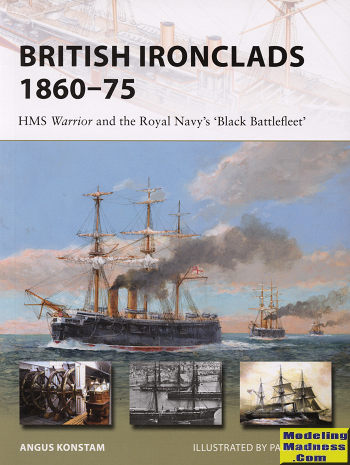 The
time around the US Civil War was a time of considerable innovation in the
development of weapons. No where was this more obvious than in the navy of
Victorian Britain. During a short time of some 15 or so year, ships went from
wooden ships augmented by steam power to fully iron steam powered ships. Not
surprisingly, the Royal Navy was not all that keen on the subject, but with the
French development of the ironclad vessel that proved relatively impervious to
current shipboard weapons, the RN had to accept the reality of the situation and
do something.
The
time around the US Civil War was a time of considerable innovation in the
development of weapons. No where was this more obvious than in the navy of
Victorian Britain. During a short time of some 15 or so year, ships went from
wooden ships augmented by steam power to fully iron steam powered ships. Not
surprisingly, the Royal Navy was not all that keen on the subject, but with the
French development of the ironclad vessel that proved relatively impervious to
current shipboard weapons, the RN had to accept the reality of the situation and
do something.
That something was to start building ironclad ships and to modify those
already under construction to this new way of building ships. The navy has
historically been rather conservative in its approach to things. It takes a bit
of a kick in the butt to get things going. However, once underway, so to speak,
events move rather quickly. So it was with the launching of the first sea-going
iron hulled war ship the HMS Warrior. While the French La Glorie was the first
ironclad, she was basically a coastal defense ship. The Royan Navy needed
something to beat the French ship and also be able to help protect the far-flung
empire.
Indeed, the Warrior and here sister ship along with following vessels
were still fully rigged, relying mostly on sail and using the engine sparingly.
These ships were able to routinely haul up the prop so it did not decrease
speed. They were also ships that relied on broadside fire power, though the guns
used for this were constantly increasing in size and reduced in number. It
wasn't until the ships started getting larger and larger that they became faster
under steam as their sheer size make them difficult to handle under sail.
During this time there was also a change in how the guns were arranged.
Ships started grouping them around the center of the ship. This allowed thicker
armor to be used around the guns. These were referred to as central battery
ships. Then there were ships that actually used turrets. These were few as the
turrets themselves were often raised for firing and had to be lowered for
reloading. This increased the time between shots. It also resulted in some
faulty designs that were poor sea-keepers. Finally, in 1873, the first true
battleship, the HMS Devastation entered service. She had no sails so there were
no masts in the way of her turrets. She proved to be a huge success and the
ironclad sailing ship disappeared into history.
The book is part of my favorite series from Osprey. These all follow a
similar format with the reason for the boat, the development of the systems and
the development of the ships themselves. This follows a logical progression of
the various types and sub-types and includes the weapons systems carried by each
one. We are provided with a short history of these classes including notable incidents and accomplishments.
It also includes a section on the operation and tactics of these vessels. Add in the superb period photographs
and illustrations and you have a super book. Also very useful is that unlike
today, the British actually preserved the HMS Warrior and so there are some
great photos of this ship included in the book.
It adds to a great series and would be what many would call a 'gateway'
book as it provides a goodly amount of information and is an impetus to those
who want to know even more. Highly recommended.
September 2018
Copyright ModelingMadness.com. All rights reserved
For more on the complete line of Osprey books, visit
http://www.ospreypublishing.com
If you would like your product reviewed fairly and
fairly quickly, please
contact
the editor or see other details in the
Note to
Contributors.
 The
time around the US Civil War was a time of considerable innovation in the
development of weapons. No where was this more obvious than in the navy of
Victorian Britain. During a short time of some 15 or so year, ships went from
wooden ships augmented by steam power to fully iron steam powered ships. Not
surprisingly, the Royal Navy was not all that keen on the subject, but with the
French development of the ironclad vessel that proved relatively impervious to
current shipboard weapons, the RN had to accept the reality of the situation and
do something.
The
time around the US Civil War was a time of considerable innovation in the
development of weapons. No where was this more obvious than in the navy of
Victorian Britain. During a short time of some 15 or so year, ships went from
wooden ships augmented by steam power to fully iron steam powered ships. Not
surprisingly, the Royal Navy was not all that keen on the subject, but with the
French development of the ironclad vessel that proved relatively impervious to
current shipboard weapons, the RN had to accept the reality of the situation and
do something.